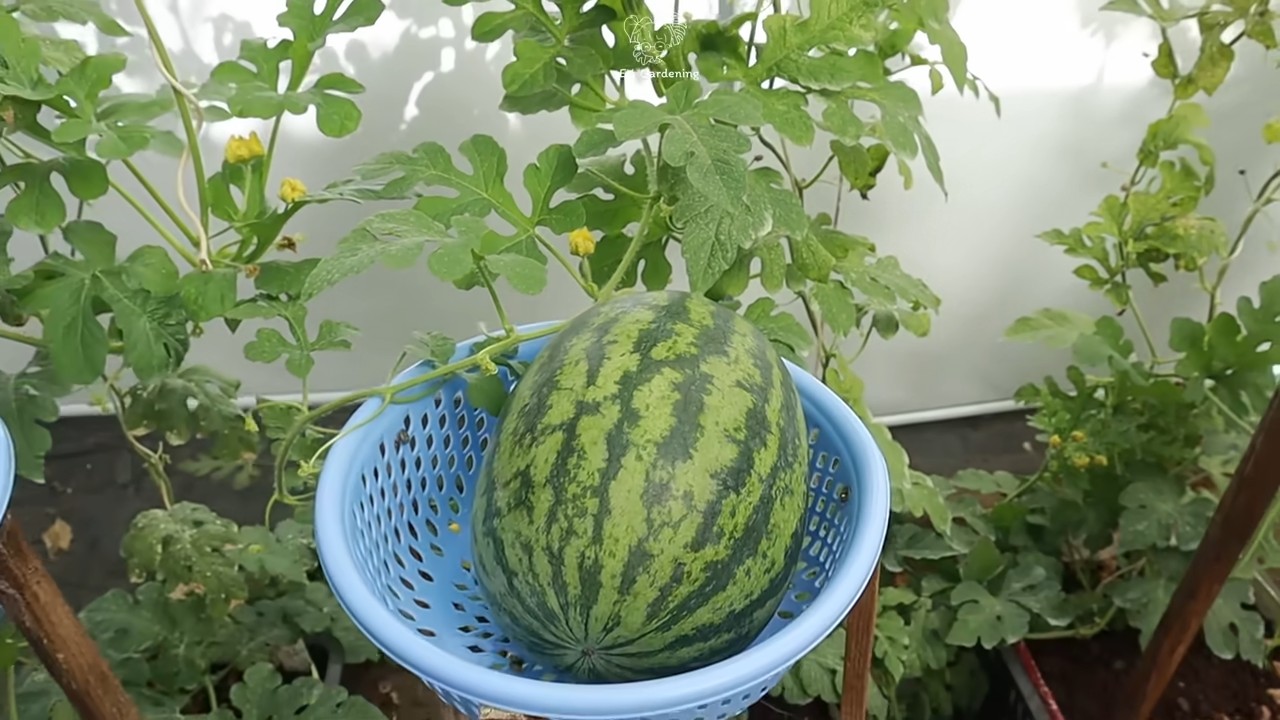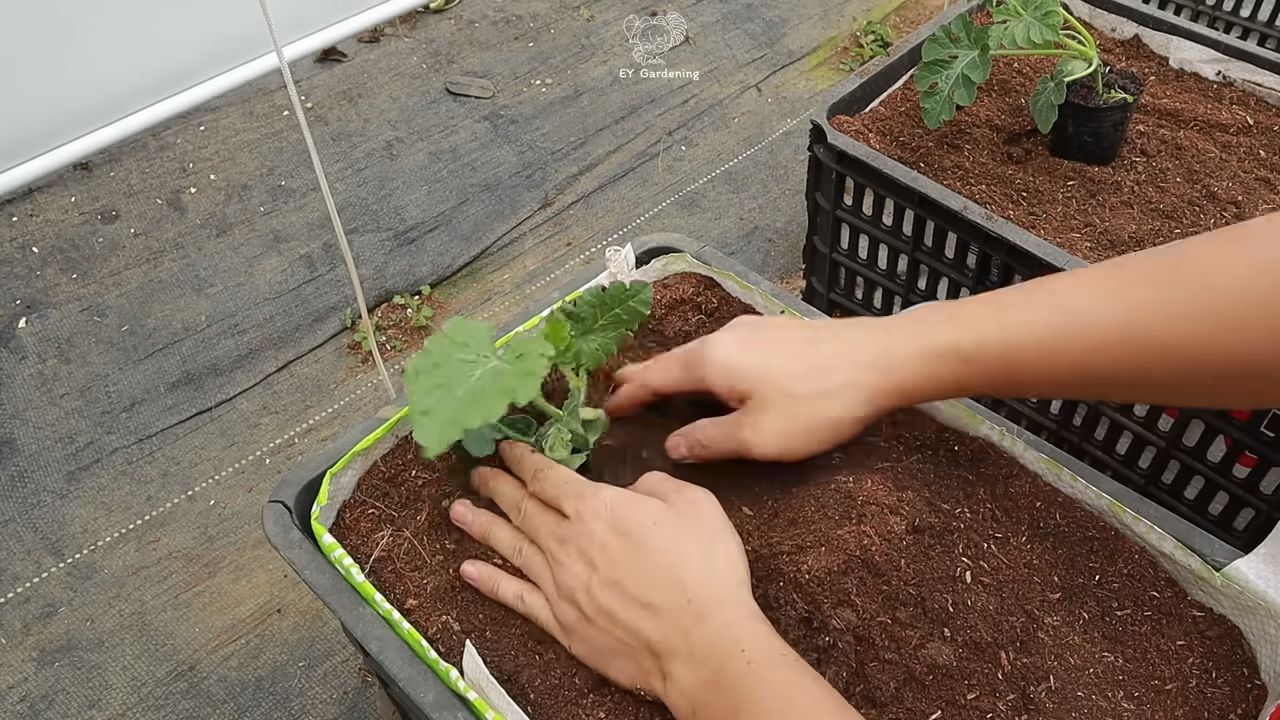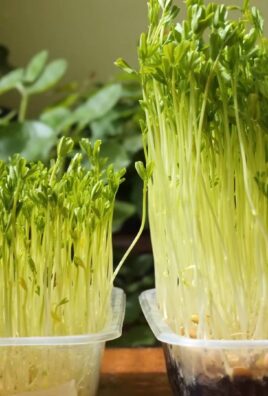Grow watermelon at home? Absolutely! Imagine biting into a juicy, sweet, homegrown watermelon on a hot summer day. Sounds like a dream, right? Well, it doesn’t have to be! For centuries, watermelons have been a symbol of summer abundance and a refreshing treat enjoyed across cultures. From ancient Egypt, where they were depicted in hieroglyphics, to modern-day picnics, watermelons hold a special place in our hearts (and stomachs!).
But what if you think you don’t have the space or the green thumb to grow watermelon at home? That’s where this DIY guide comes in! Many people believe growing watermelons is only for large farms, but I’m here to tell you that with a few clever tricks and hacks, you can cultivate these delicious fruits even in a small garden or on a sunny balcony. We’ll explore simple, effective techniques that will help you overcome common challenges and maximize your yield.
This article is packed with easy-to-follow instructions and insider tips that will empower you to successfully grow your own watermelons. Say goodbye to bland, store-bought watermelons and hello to the satisfaction of harvesting your own sweet, juicy bounty. Let’s get started and turn your gardening dreams into a delicious reality!

Growing Watermelons: A Sweet Summer Project You Can Do at Home!
Okay, let’s be honest, who doesn’t love a juicy, sweet watermelon on a hot summer day? And the best part? You can totally grow your own! It might seem intimidating, but with a little planning and effort, you can be enjoying homegrown watermelons before you know it. I’m going to walk you through everything you need to know, from choosing the right variety to harvesting your prize-winning melon.
Choosing the Right Watermelon Variety
First things first, you need to pick the right watermelon variety for your climate and garden size. Some watermelons are huge, while others are more compact. Here’s a breakdown to get you started:
* Consider your climate: Some varieties are better suited for warmer climates with long growing seasons, while others are more tolerant of cooler temperatures.
* Think about space: Watermelons need a lot of space to sprawl. If you have a small garden, look for bush or dwarf varieties.
* Popular varieties:
* Sugar Baby: A classic, small, and sweet watermelon that matures quickly. Great for smaller gardens.
* Crimson Sweet: A larger, oblong watermelon with a bright red flesh and excellent flavor.
* Jubilee: A large, oblong watermelon with a thick rind, making it good for shipping and storage.
* Bush Sugar Baby: A compact version of Sugar Baby, perfect for containers or small gardens.
* Yellow Doll: A unique watermelon with yellow flesh and a sweet, honey-like flavor.
Getting Started: Planting Your Watermelon Seeds
Now that you’ve chosen your variety, it’s time to get those seeds in the ground! You can either start your seeds indoors or direct sow them in your garden. I usually prefer starting them indoors to get a head start, especially if you live in an area with a shorter growing season.
* Starting seeds indoors (recommended):
* Timing: Start your seeds about 4-6 weeks before the last expected frost.
* Containers: Use peat pots or biodegradable containers. Watermelons don’t like their roots disturbed, so these types of containers will make transplanting easier.
* Soil: Use a good quality seed-starting mix.
* Planting: Plant 2-3 seeds per pot, about 1 inch deep.
* Watering: Keep the soil consistently moist, but not soggy.
* Light: Provide plenty of light. A sunny windowsill or grow lights will work.
* Thinning: Once the seedlings emerge, thin them to one strong seedling per pot.
* Direct sowing (if your climate is warm enough):
* Timing: Wait until the soil temperature is consistently above 70°F (21°C).
* Location: Choose a sunny spot with well-drained soil.
* Planting: Plant seeds about 1 inch deep, spacing them according to the variety’s recommendations (usually 2-3 feet apart).
* Watering: Keep the soil consistently moist until the seedlings emerge.
Preparing Your Garden Bed
Watermelons are heavy feeders, so preparing your garden bed is crucial for success. They need nutrient-rich soil and plenty of sunlight.
* Sunlight: Watermelons need at least 6-8 hours of direct sunlight per day.
* Soil: Watermelons prefer well-drained, sandy loam soil with a pH between 6.0 and 6.8.
* Amendments:
* Compost: Add plenty of compost to your garden bed to improve soil fertility and drainage.
* Manure: Well-rotted manure is another great amendment for watermelons.
* Fertilizer: You can also add a balanced fertilizer (e.g., 10-10-10) to your garden bed. Follow the instructions on the fertilizer package.
* Raised beds: Consider growing watermelons in raised beds if your soil is heavy or poorly drained.
Transplanting Your Watermelon Seedlings
Once your seedlings have developed a few true leaves and the weather has warmed up, it’s time to transplant them into your garden.
1. Harden off your seedlings: Before transplanting, gradually acclimate your seedlings to outdoor conditions by exposing them to increasing amounts of sunlight and wind over a period of 7-10 days.
2. Choose a cloudy day: Transplanting on a cloudy day will help reduce stress on the seedlings.
3. Dig holes: Dig holes that are slightly larger than the peat pots or containers your seedlings are in. Space the holes according to the variety’s recommendations.
4. Plant the seedlings: Gently remove the seedlings from their containers and plant them in the holes. If you’re using peat pots, make sure to tear off the top part of the pot to prevent it from wicking moisture away from the roots.
5. Water thoroughly: Water the seedlings thoroughly after transplanting.
6. Mulch: Apply a layer of mulch around the plants to help retain moisture, suppress weeds, and regulate soil temperature. Straw, wood chips, or black plastic mulch are all good options.
Caring for Your Watermelon Plants
Now that your watermelon plants are in the ground, it’s important to provide them with the care they need to thrive.
* Watering: Watermelons need consistent moisture, especially during fruit development. Water deeply and regularly, especially during dry spells. Avoid overhead watering, as this can lead to fungal diseases. Drip irrigation is a great option for watermelons.
* Fertilizing: Side-dress your watermelon plants with a fertilizer high in phosphorus and potassium when the fruits start to develop. This will help promote fruit growth and sweetness.
* Weeding: Keep your garden bed free of weeds, as they can compete with your watermelon plants for nutrients and water.
* Pruning: While not essential, pruning can help improve air circulation and fruit production. Remove any suckers (small shoots that grow from the base of the plant) and any yellowing or diseased leaves.
* Pollination: Watermelons need to be pollinated in order to produce fruit. Bees are the primary pollinators of watermelons. If you don’t have many bees in your area, you may need to hand-pollinate your plants. To hand-pollinate, use a small paintbrush to transfer pollen from the male flowers to the female flowers. Female flowers have a small fruit at the base of the flower.
* Vine Training: As the vines grow, you can train them to grow in a specific direction to maximize space and sunlight exposure. You can also use trellises for smaller varieties.
Protecting Your Watermelons from Pests and Diseases
Watermelons can be susceptible to a variety of pests and diseases. Here are some common problems and how to deal with them:
* Pests:
* Aphids: These small, sap-sucking insects can weaken your plants. Spray them with insecticidal soap or neem oil.
* Cucumber beetles: These beetles can damage leaves and transmit diseases. Use row covers to protect your plants or spray them with an insecticide.
* Squash bugs: These bugs can suck the sap from your plants and cause them to wilt. Handpick them off your plants or spray them with an insecticide.
* Melon worms: These caterpillars can bore into your watermelons and ruin them. Use row covers to protect your plants or spray them with an insecticide.
* Diseases:
* Powdery mildew: This fungal disease causes a white, powdery coating on the leaves. Improve air circulation and spray your plants with a fungicide.
* Fusarium wilt: This fungal disease causes the plants to wilt and die. Plant resistant varieties and practice crop rotation.
* Anthracnose: This fungal disease causes dark, sunken spots on the leaves and fruits. Improve air circulation and spray your plants with a fungicide.
Harvesting Your Watermelons
The most exciting part! Knowing when to harvest your watermelons can be tricky, but here are a few signs to look for:
1. The tendril closest to the fruit turns brown and dries up: This is a reliable indicator that the watermelon is ripe.
2. The bottom of the watermelon (where it rests on the ground) turns from white to yellow: This is another sign that the watermelon is ripe.
3. The watermelon sounds hollow when you thump it: This is a more subjective test, but with practice, you’ll be able to tell when a watermelon is ripe by the sound it makes.
4. The rind becomes dull and loses its shine: A ripe watermelon will have a dull,

Conclusion
So, there you have it! Growing watermelons at home might seem daunting at first, but with a little planning, preparation, and the right DIY tricks, you can be harvesting your own juicy, sweet watermelons before you know it. This isn’t just about saving money; it’s about experiencing the unparalleled satisfaction of nurturing a plant from seed to fruit, knowing exactly what went into its growth, and enjoying a flavor that far surpasses anything you can find in a store.
This DIY approach to watermelon cultivation empowers you to take control of your food source and connect with nature in a meaningful way. Imagine the pride you’ll feel serving slices of your homegrown watermelon at your next summer barbecue, knowing you cultivated it yourself. The vibrant color, the refreshing taste, and the sheer abundance of a successful watermelon harvest are rewards well worth the effort.
But don’t stop there! Experiment with different watermelon varieties to discover your personal favorite. Try growing smaller, personal-sized watermelons in containers if you’re short on space. Consider companion planting with herbs like basil or marigolds to deter pests and enhance the flavor of your watermelons. You can even explore different trellising methods to maximize space and improve air circulation around your plants. The possibilities are endless!
This DIY watermelon growing method is a must-try for anyone who loves fresh, flavorful produce and enjoys the rewarding experience of gardening. It’s a fantastic way to get your hands dirty, learn about the natural world, and enjoy the fruits (literally!) of your labor.
We encourage you to take the plunge and give this DIY trick a try. Don’t be afraid to experiment, learn from your mistakes, and adapt the techniques to suit your specific climate and growing conditions. And most importantly, share your experience with us! We’d love to hear about your successes, challenges, and any tips or tricks you discover along the way. Post photos of your watermelon plants, share your harvest stories, and let us know what worked best for you. Together, we can create a community of passionate home gardeners who are dedicated to growing delicious, healthy watermelons. So, grab your seeds, prepare your soil, and get ready to embark on a rewarding watermelon-growing adventure! You won’t regret it.
Frequently Asked Questions (FAQ)
1. What is the best time to start growing watermelons?
The ideal time to start growing watermelons depends on your climate. Watermelons are warm-season crops and require a long growing season of at least 70-90 days. In general, you should start seeds indoors about 6-8 weeks before the last expected frost. If you live in a warmer climate with a longer growing season, you can direct sow seeds outdoors once the soil temperature reaches at least 70°F (21°C). Check your local frost dates and adjust your planting schedule accordingly.
2. What kind of soil is best for growing watermelons?
Watermelons thrive in well-drained, sandy loam soil that is rich in organic matter. The soil should have a pH between 6.0 and 6.8. Before planting, amend your soil with compost, aged manure, or other organic materials to improve drainage, fertility, and water retention. Avoid heavy clay soils, as they can become waterlogged and inhibit root growth. If you have clay soil, consider growing watermelons in raised beds or containers with a well-draining potting mix.
3. How much sunlight do watermelons need?
Watermelons require at least 6-8 hours of direct sunlight per day to produce abundant, sweet fruit. Choose a planting location that receives full sun throughout the day. If your garden is shaded for part of the day, try to select a spot that gets morning sun, as this will help dry the leaves and reduce the risk of fungal diseases.
4. How often should I water my watermelon plants?
Watermelons need consistent moisture, especially during fruit development. Water deeply and regularly, aiming to keep the soil consistently moist but not waterlogged. Water at the base of the plants to avoid wetting the foliage, which can encourage fungal diseases. During hot, dry weather, you may need to water daily. Reduce watering as the fruits ripen to prevent them from splitting.
5. What are some common pests and diseases that affect watermelons?
Common pests that can affect watermelons include aphids, squash bugs, cucumber beetles, and vine borers. Diseases include powdery mildew, fusarium wilt, and anthracnose. Regularly inspect your plants for signs of pests or diseases and take appropriate action. You can use organic pest control methods such as insecticidal soap, neem oil, or handpicking pests. To prevent diseases, ensure good air circulation around your plants, avoid overhead watering, and practice crop rotation.
6. How do I know when my watermelons are ripe?
Determining when a watermelon is ripe can be tricky, but there are several indicators to look for. The tendril closest to the fruit should be brown and dry. The underside of the watermelon, where it rests on the ground (the “ground spot”), should be yellow or cream-colored. When you thump the watermelon, it should sound dull and hollow. Also, the skin should be slightly dull and resistant to scratching. With practice, you’ll learn to recognize the signs of a ripe watermelon.
7. Can I grow watermelons in containers?
Yes, you can grow watermelons in containers, but you’ll need to choose a smaller, bush-type variety and use a large container (at least 20 gallons). Ensure the container has good drainage and use a high-quality potting mix. Water container-grown watermelons more frequently than those grown in the ground, as the soil in containers tends to dry out faster. You may also need to provide support for the vines as they grow.
8. What are some good companion plants for watermelons?
Companion planting can help deter pests, attract beneficial insects, and improve the overall health of your watermelon plants. Good companion plants for watermelons include basil, marigolds, nasturtiums, oregano, and rosemary. These herbs can help repel pests like aphids and squash bugs. Flowers like sunflowers and zinnias can attract pollinators, which are essential for fruit production.
9. How can I improve the sweetness of my watermelons?
Several factors can influence the sweetness of your watermelons. Ensure your plants receive plenty of sunlight and water. Avoid over-fertilizing with nitrogen, as this can promote leafy growth at the expense of fruit production. Provide adequate potassium and phosphorus, which are essential for fruit development and sweetness. Allow the watermelons to ripen fully on the vine before harvesting.
10. What do I do if my watermelon plant is not producing fruit?
There are several reasons why your watermelon plant might not be producing fruit. Ensure your plants are receiving enough sunlight, water, and nutrients. Pollination is crucial for fruit set, so make sure there are plenty of pollinators in your garden. You can also hand-pollinate the flowers if necessary. If the weather is too hot or too cold, it can also affect fruit production. Finally, make sure you are growing a variety that is well-suited to your climate.





Leave a Comment